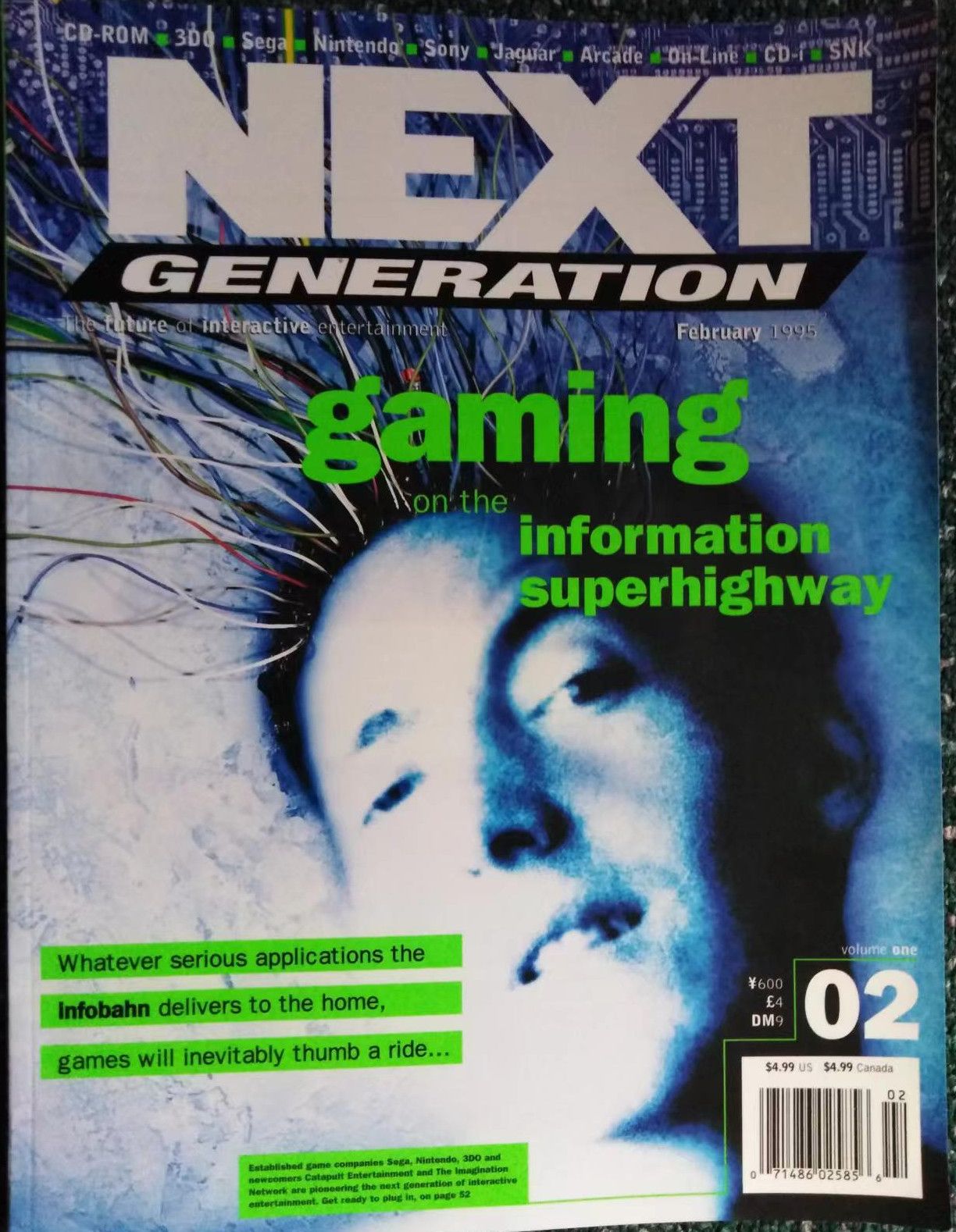Welcome to the Next Level: The History of Next Generation Magazine
The gaming magazine that re-wrote the rules

I'm not sure exactly where I picked up a copy of Next Generation #2 – a minor gift or a roadside child silencer, perhaps. I wouldn't even bother with a question like that if I didn't end up with a subscription to the magazine just a few years later after Game Players went to the happy hunting ground.
It is an oddly pretty keepsake – easily the highest quality magazine I've ever had in my hands. Next Generation really went out of its way to impress in those early days, with a durable matte cover and heavy stock for the pages. This was a publication meant to endure, something to be kept in a magazine holder for future reference.

Shame that Next Generation as a whole didn't last as long. Seven years, 85 issues and one rebrand to NextGen later, and the publication joined its sister magazine in the great beyond. But as with Game Players, Next Generation was around just long enough to make an impact. The team behind the magazine had tried to create a big-picture publication that was very different than what one might have found on the newsstands in 1995, and in doing so they introduced some new ideas into the marketplace.
So let's take a closer look at Next Generation #2 and see what made it unique.
Designed different
There were two chief appeals in the old-school video game magazine: Information about games one might want to buy, and information on games one already owned. Therefore, the two most significant sections – the must-haves for any publication – were reviews and strategy. Whatever other specialties might be present, these were obligatory.
Broadly, this split magazines into two types based on which area was the focus. Magazines such as EGM were buyer's guides, with a large portion of the content pages used for reviews and (to a lesser extent) previews. Meanwhile, magazines like Nintendo Power were strategy publications, turning a greater share of the pages over to walkthroughs and codes. No magazine would exclude either of these sections, as they were each too important, but that focus did a lot to define the audience.
Next Generation did not fall neatly into either category. It was trying to be something altogether different.

Let's take a look at what Next Generation #2 had to offer – or, more precisely, what it didn't offer. A strategy section, for one. Most iterations of Next Generation didn't feature walkthroughs, and versions that did have such a section only gave it a few pages.
What about reviews? By the numbers, Next Generation did come through in that department. This issue contains a whopping sixty reviews, including systems (such as the CD-i) that other publications had little time for. The caveat is that these sixty reviews are crammed into a mere 12 pages. For those of you who never excelled at math, that would be five per page.
What, exactly, does a 1/5thof a page game review look like? The higher profile titles managed to snag a half-page spread, leaving enough room for two small screenshots. Lesser titles had to make do with a single paragraph of about 100 words and no screenshot. That tiny one-to-five star rating had to do a lot of heavy lifting.

Later versions of Next Generation added some slack to the reviews, allowing for the same one-page reviews that were standard in the business (though the mammoth six-page reviews one might see in the likes of PC Gamer were out of the question). Even so, it's clear that the guts of video game journalism were not the focus of Next Generation.
So what did they do with all the space they saved? That's where it got interesting.
Creator interviews
Next Generation was published during the high age of the rock star game developer, a time when a big name could move a game all by itself. The personalities only grew with the games, as some of these figures became known as much for their personal lives as for their work. As public fascination with these figures grew, the developer interview became an increasingly sought-after prize, especially for the most famous names.
Next Generation #2 includes a six-page interview with Shigeru Miyamoto. Was that a big enough name?

Interviews of that caliber were hardly rare for Next Generation. In just the first year I was subscribed to the magazine, it included interviews with Gabe Newell, John Carmack, Trip Hawkins and Hironobu Sakaguchi. But it wasn't just the rock stars – Next Generation would talk with anyone who might have insight on the industry, from CEOs of major hardware and software companies to entire world-class dev teams.
Next Generation's interviews are probably its most visible legacy. In fact, I have a feeling that you've seen one, even if you're not familiar with the magazine at all. Many retrospectives and video essays make use of NG interviews to give insight on the industry as it once was. It's actually not too surprising to see these interviews keep showing up, as they are not just longer but more thorough than typical interviews of the time, which were usually just disguised PR for an upcoming title.
Epic features
Somehow, these big deal interviews were still not the magazine's main draw – note that the Miyamoto interview didn't even make the cover. The heart of Next Generation was something all but unknown in the industry at the time – feature writing.
Next Generation #2 includes two feature articles: A four-page feature on retro gaming (a term I didn't even know was in regular use in 1995) and a ten-page feature on online gaming services, then still very new. It's the latter article that dominates the cover, taking up space that on any other publication would display art from some exclusive preview.
For what it's worth, it is a very interesting article – more interesting in retrospect, maybe, given that online gaming now dominates the scene and yet the services they described are mere curios in the history of the internet. What's surprising is that it exists at all, let alone that they put it on the cover. We've grown used to seeing long feature articles (you know, like this one) on video game websites, but in the 90's this just wasn't done. You might occasionally see a feature piece on a new console, something that would amount to an extended preview, but articles on games and the film industry, or AI design, or secret behind-the-scenes programming tricks – all Next Generation articles – were all but unheard of.

This may have been Next Generation's bigger contribution to the industry. True, their interviews continue to circulate, but without the magazine mainstreaming the concept of video game feature writing, those interviews would have nowhere to go.
Industry vs consumer
I think the original intent behind Next Generation was to create a publication for the industry, rather than the consumer. It explains a lot of the early choices – the tiny reviews section relative to the large full-page previews, the interviews with figures who might not have always been interesting to the usual game magazine audience, the focus on into-the-reeds feature writing. Even the high physical quality speaks to something meant to appeal to a more affluent, connected audience. It was to be a publication for the movers and shakers, as well as those with ambitions of a career in the industry.
As so often happens with ambitious projects, reality intervened. Next Generation came to more resemble a conventional buyer's guide, particularly after the NextGen rebrand. The interviews and feature writing were still there, but were a relatively small part of the magazine.
Yet a bit of the old ambition still lived on. When I received my subscription in 1998, Next Generation still included one tiny little feature that really pulls all of this together. In the back of every issue, occupying a few spare pages in the layout, were several help wanted ads for various game-related companies. In issue #2, this included Spectrum, Iguana and Virgin Interactive. Ads like this weren't unique to Next Generation, but I never saw another magazine that listed their presence in the table of contents.
The Next Generation brand lasted a bit longer than the magazine, existing as an industry-focused website from 2005 to 2008 before being swallowed up by its editorial cousin Edge. But while the idea of an industry-focused publication never quite took hold, the magazine left its mark all the same.
Scans of the complete run of Next Generation are available on Retro CDN.
